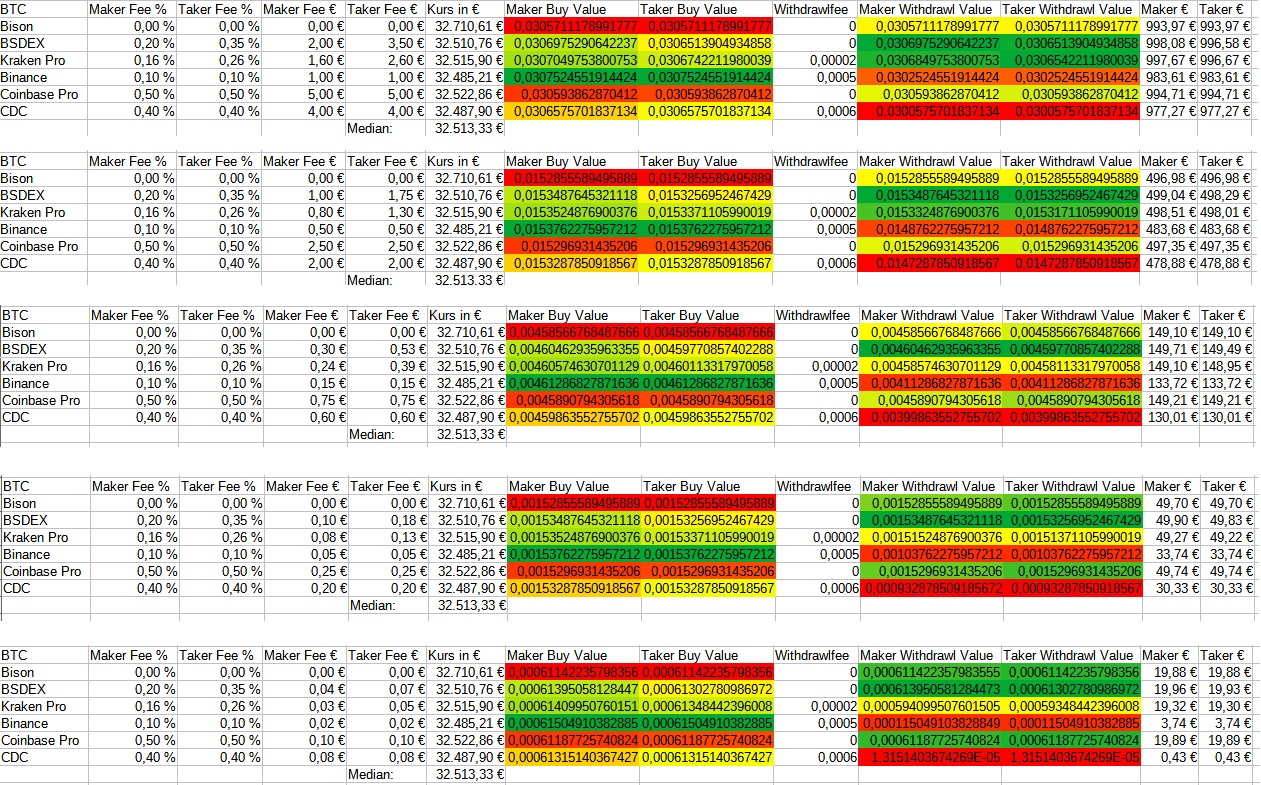𝙺𝚛𝚢𝚙𝚝𝚘𝚋ö𝚛𝚜𝚎𝚗 𝚅𝚎𝚛𝚐𝚕𝚎𝚒𝚌𝚑 - 𝚗𝚊𝚌𝚑𝚛𝚎𝚌𝚑𝚗𝚎𝚗
Trust is good, control is better.
I had posted a review on crypto exchanges a while back (see link tree) and listed factors that can go into deciding for / against an exchange. Since the price plays the main role for most people in the end, let's do the math.
The price is composed of 2-3 factors, price, trading fee and in the case that we transfer to our own wallet, the cost of withdrawal.
𝐇𝐚𝐧𝐝𝐞𝐥𝐬𝐠𝐞𝐛ü𝐡𝐫
When it comes to trading fees, it is important to note that many exchanges have different levels. The more traded the lower the fee. There are also bonuses if you hold certain coins or use certain trading pairs.
Therefore, I would like to briefly explain why I do not consider such bonuses but always take the base fee. The levels are calculated according to rolling 30 day windows and start at values that probably few reach here. The lowest turnover level has Coinbase with 10k / 30d. My intention is not so much to calculate the best for someone specifically but to give a general advice and show how to calculate it for yourself. In a separate post I will explain how to build a spreadsheet with LibreOffice that works with live data. Because hardly anyone wants to calculate by hand.
𝐊𝐮𝐫𝐬𝐩𝐫𝐞𝐢𝐬
Of course, in order to be able to compare, the trading prices must be in a single currency. In order for the prices of the individual exchanges to be fairly comparable, I would personally choose a trading pair that is as liquid as possible. Although many exchanges offer, for example, the pair BTC-EUR, the price here is usually worse than, for example, BTC-USDT. In this respect, I would always query the price of the BTC-USDT pair for a comparison, if available, and then convert it to euros. For this, I pull the EUR-USDT rate from Binance, as it is the largest exchange. For exchanges that only offer USD rates, I pull the USD-USDT rate from Kraken and do the same conversion.
𝐀𝐮𝐬𝐳𝐚𝐡𝐥𝐮𝐧𝐠𝐬𝐤𝐨𝐬𝐭𝐞𝐧
If you want to pull cryptocurrency to your wallet, most exchanges charge for this. These can be divided into 2 categories. Withdrawal fee and network fee.
The withdrawal fee is taken by the exchange and put into its own pocket to subsidize e.g. low trading fees. The network fee accrues on the cryptocurrency's blockchain and can therefore only be partially influenced by the crypto exchange. Therefore, I only take the withdrawal fee for the calculation. Of course, one should keep in mind that plus the payout fee, the network fee would still have to be taken into account to have a complete picture.
𝐄𝐧𝐝𝐰𝐞𝐫𝐭𝐞 𝐯𝐞𝐫𝐠𝐥𝐞𝐢𝐜𝐡𝐞𝐧
Comparing the nominal amount of cryptocurrency is simplistic, of course. More interesting is the question if one also considers a comparison in € useful. After all, if one has completed a transfer to one's own wallet, one would theoretically be free to sell the cryptocurrency on another exchange. I multiply the nominal value of the cryptocurrency by the median of the buying prices. Whether that makes sense given the rapid price changes, the fact that they are buy prices and the payout delay ... no idea. Of course, you can also just multiply by the buy rate, then you end up with investment amount minus fees.
𝗦𝗼𝗻𝘀𝘁𝗶𝗴𝗲 𝗔𝗻𝗺𝗲𝗿𝗸𝘂𝗻𝗴𝗲𝗻
Courses I queried 22:55 on 01/27. In case it is not obvious, the simulation values are 1000€, 500€, 150€, 50€ and 20€.
Bison and BSDEX do not incur network fees on payout as they are settled by the exchange. This is not reflected in the calculation as described. The relevance of the network fee increases the smaller the investment amount is.
Bison has no maker / taker fee in the actual sense, since there is no order book and the fee is directly in the spread of the price. Therefore, Bison is obviously the worst in a pure comparison of prices.
BSDEX does not offer an official API for price queries. The API I know (but for such a thing is not really intended) needs an authtoken, that does not work from the table. Therefore I have taken the price manually at the time of query.
𝐅𝐚𝐳𝐢𝐭
BSDEX and Bison shine at low amounts and the exchanges offer a strong incentive to cash out coins directly. This is good, then you should not leave your coins on exchanges for no particular reason. On the upside, Bison is losing out to BSDEX. However, it should be remembered again that the network fee is to be paid at Coinbase and Kraken itself, which levels out the anyway small difference in the 1000€ case. Those who only want to leave their coins on the exchange would probably be best served with Binance.
The attached image externally: https://i.ibb.co/qj1y61R/image.png
𝗠ö𝗴𝗹𝗶𝗰𝗵𝗲 𝗙𝗿𝗮𝗴𝗲𝗻
Q: 𝖶𝖺𝗋𝗎𝗆 𝖾𝗆𝗉𝖿𝗂𝖾𝗁𝗅𝗌𝗍 𝖽𝗎 𝖡𝗂𝗌𝗈𝗇 𝗌𝗍𝖺𝗍𝗍 𝖡𝖲𝖣𝖤𝖷 𝗎𝗇𝖽 𝗐𝖺𝗌 𝗇𝗎𝗍𝗓𝗍 𝖽𝗎 𝗌𝖾𝗅𝖻𝗌𝗍?
A: In short with Bison there is less you can't understand or do wrong. BSDEX runs with order book but has some rules that are different from all other providers. There are trading, liquidity, volatility breaks and auctions. The thin liquidity can lead to buying at worse prices if you just throw a market order in. Likewise, the supply of coins is smaller than Bison and Bison offers the ability to set up savings plans. I myself use BSDEX for limit purchases and Bison for savings plan.
Q: 𝖠𝖻𝖾𝗋 𝖽𝖺𝗌 𝗂𝗌𝗍 𝗇𝗎𝗋 𝖾𝗂𝗇 𝖾𝗂𝗇𝗓𝖾𝗅𝗇𝖾𝗋 𝖹𝖾𝗂𝗍𝗉𝗎𝗇𝗄𝗍!
A: Yes, anyone, at any time is free to do the math themselves. That's why I explained how I do it.
Q: 𝖬𝖾𝗂𝗇𝖾 𝖫𝗂𝖾𝖻𝗅𝗂𝗇𝗀𝗌𝖻ö𝗋𝗌𝖾 𝖻𝗂𝖾𝗍𝖾𝗍 𝗏𝗂𝖾𝗅 𝗆𝖾𝗁𝗋 𝖺𝗅𝗌 𝗇𝗎𝗋 𝖽𝖾𝗇 𝖧𝖺𝗇𝖽𝖾𝗅 𝗆𝗂𝗍 𝖡𝗂𝗍𝖼𝗈𝗂𝗇!
A: Yeah, that's not what this is about, unfortunately.
Q: 𝖡𝗂𝗍𝖼𝗈𝗂𝗇 𝗂𝗌𝗍 𝖽𝗈𝗈𝖿, 𝗂𝖼𝗁 𝗆𝖺𝗀 𝖳𝗈𝖺𝗌𝗍𝖻𝗋𝗈𝗍!!!𝟣
A: Bon appetit.













